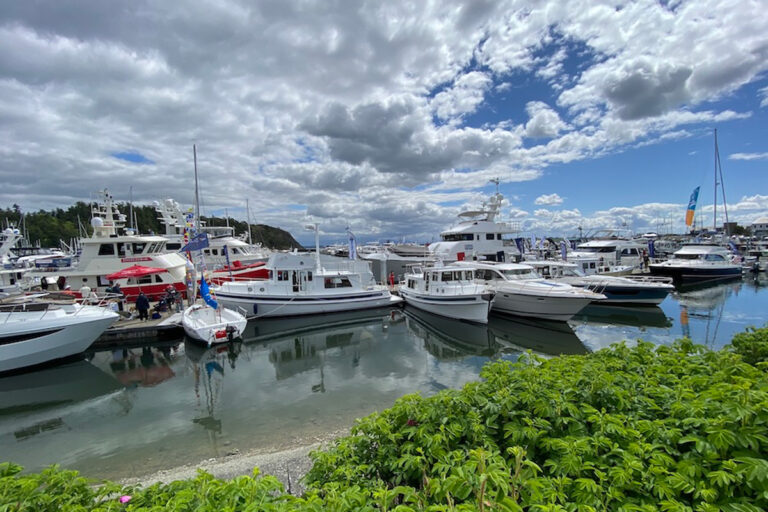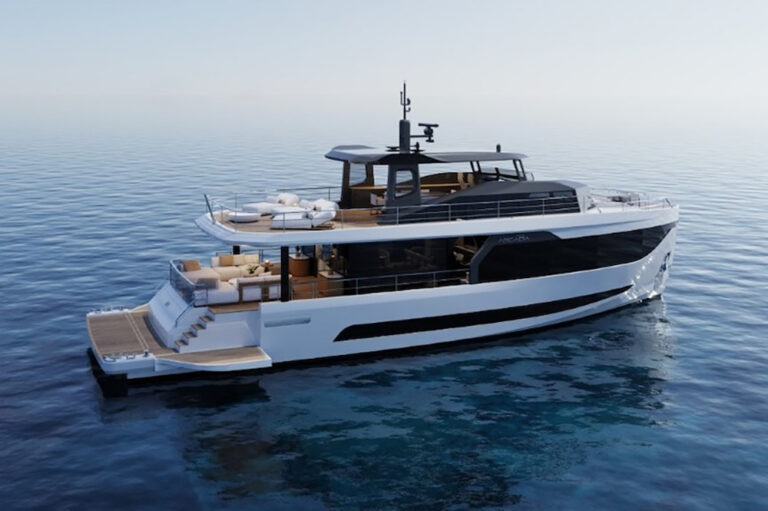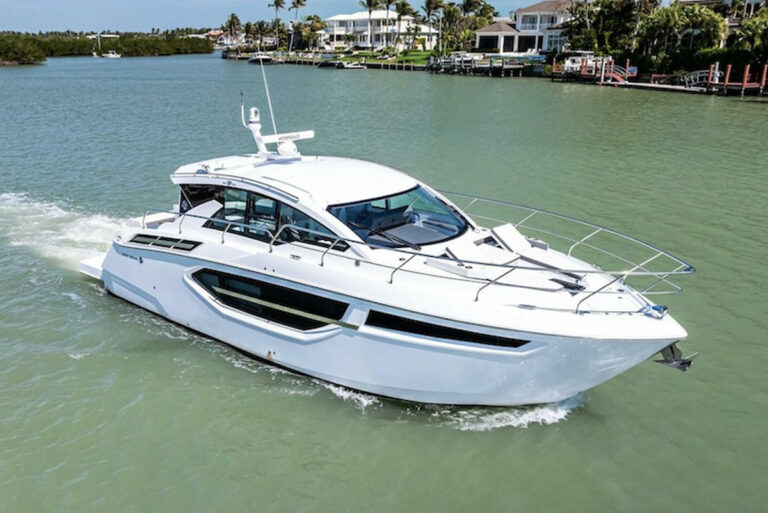
yachting/images/magazine/2007/052007/fea_driven5_550x219.jpg
In YACHTING’s inaugural issue of January 1907, the renowned author W.P. Stephens wrote an article titled “The Development of the Power Boat” (1897-1907). “The step from the old pleasure launch of 10 years ago to the modern powerboat was made possible by the development of the engine,” Stephens wrote. That’s been the case for more than a century, and from that time onward, YACHTING has kept its readers up to date with the rapid progress of internal-combustion engines and the drive trains they spin.
Powerboat buyers of 1907 could choose from a wide range of power plants, most of them physically large and very heavy for their power output. The Charles L. Seabury Company, like many of its contemporaries, offered steam engines and internal-combustion engines fueled with gasoline, alcohol, naphtha and hot oil. An article about a modern 60-foot, 13-mph, twin-screw cruiser highlighted the progress that had been made in gasoline engines, pointing out that the latest engines could operate at varying speeds, while the “old engines ran well only in the range of 300 to 400 rpm and that any effort to alter that range would not succeed.
Steam engines powered the superyachts of YACHTING’s early days, and they required a full-time engineer. An article in one of the early issues pegged the fuel bill at $75 ($1,600 today), when running 10 hours and using 20 to 25 tons of coal. Fuel for marine engines also included gasoline, fuel oil (kerosene and diesel) and alcohol, whose future as a fuel for internal-combustion engines was questioned with the note that it was not cost- competitive with gasoline. The 84-foot yacht Idealia, built in 1911 by the Electric Launch Company (ELCO), was the first powered by a diesel (a six-cylinder two-stroke) burning heavy oil. Typical of the easily driven design of that time, Idealia was long and thin, with a beam of only 13 feet, 8 inches. She consumed seven gallons diesel fuel (at three cents per gallon) cruising at 12 knots (1.7 nm/gal). Fast cruisers of 1911, equipped with a pair of 300 hp six-cylinder gasoline engines, could reach 25 mph. The megayachts of the day were transitioning from reciprocating steam engines to steam turbines.
As today, some yachtsmen were in a hurry. The January 1918 issue of YACHTING reported the opinion of Commodore Albert N. Judson, president of the American Power Boat Association, that speeds would exceed 100 miles per hour in only a few years. He based his prediction on the fact that his 28-foot hydroplane, Whip-po-Will Jr., was then running at almost 70 mph, a substantial improvement from the 30-mph record of 1907. Making the boat’s high speed possible: high-temperature metals for the engine’s valves and spark plugs whose electrodes were made of solid platinum, at a cost per plug of $20 (four plugs were used for each of the engine’s 12 cylinders, so a set cost $960).
After World War I, improvements in the design of high-speed boats came at a rapid pace, spurred in part by the use of powerful and relatively lightweight surplus WWI aircraft engines. Many new engines also were adapted from the greatly improved automobile engines. Diesel-engine development also progressed rapidly, with some of the first Caterpillar engines used in boats in the mid ’30s. At that time, an 1800 rpm, 90 hp Cat D 468 diesel weighed 2,120 pounds, 23.5 pounds per horsepower. The new Detroit 6-71 diesel engine of 1938 was marinized by Westerbeke and led the way toward higher speed (2100 rpm) diesel power for boats and yachts, a trend that continued with the growing use of small-vehicle diesel engines following World War II. The trend toward lighter, higher-speed diesel power continues unabated, with some of today’s marine diesels turning at over 4000 rpm.
SAIL POWER
In 1907 sails were laced to mast hoops and, with the exception of a few very large yachts, hoisted on wooden masts. Running rigging was made of natural fibers; standing rigging was manila rope or plow steel.
Nevertheless, Nathanael Herreshoff’s 1903 America’s Cup yacht, Reliance, set 17,000 square feet of sail, enough to impress anyone sailing today. Herreshoff’s influence extended to all areas of the sport of sailing, and among the innovations credited to the Wizard of Bristol are sail tracks and slides, crosscut sails, hollow aluminum masts, two-speed winches and the belowdecks winches used on some of his Cup designs.
Running rigging required considerable care, especially in preventing it from rotting, but it had a good “hand and was easy to work with. Until the late 1940s, sails were made of canvas, with the best yacht sails woven from Egyptian cotton, and they were heavy. The sails and the natural fiber thread used to assemble them were more susceptible to damage from ultraviolet radiation than today’s synthetics. After the first advertisements for nylon sails appeared in YACHTING in 1946, a host of new materials followed-polyester, polyethylene, liquid crystal polymers, Kevlar, carbon and Cuben fiber. Sails have progressed from flat to crosscut designs made of woven material to advanced woven constructions, laminates and molded, three-dimensional shapes that closely resemble an aircraft wing. Carbon-fiber masts and booms are commonplace on high-performance yachts, including the towering unstayed masts on Maltese Falcon, the yacht that illustrates the magnitude of the progress achieved in sail propulsion during the past 100 years. Falcon sets a total of 25,791 square feet of synthetic fabric sail on her three unstayed, rotating, carbon-fiber masts. The 288-foot, 2,777,600-pound yacht can set all of its 15 pushbutton controlled, internally furled sails without the need for anyone to go aloft or even tend a winch. Falcon’s square-sail configuration (some supposedly obsolete ideas are successfully reborn when technology advances) allows the yacht to set a cloud from masts that at 190 feet above the deck are about 100 feet shorter than what would have been required with a Marconi or Bermuda rig.
By the ’20s auxiliary power was becoming common on larger sailing yachts and remained relatively uninspiring until the invention of the saildrive, marketed now by Volvo and Yanmar.
As we look to the future, we can expect to see improvements in diesel/electric propulsion, with significant contributions from solar energy and maybe practical fuel cells. Progress in sailing rigs remains somewhat in the hands of the handicappers, but surprises will come, as always, from those who dream.









